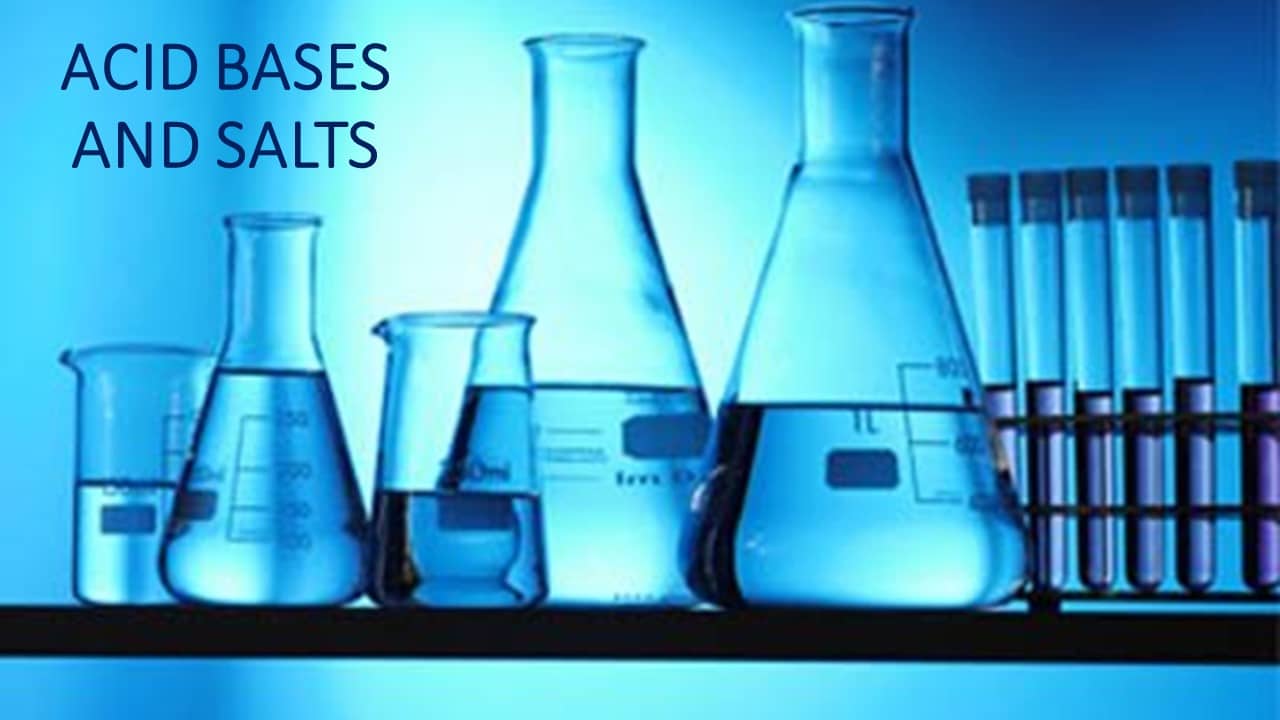STD X – STUDY OF ACID BASES AND SALTS – EINSTEIN
About Course
In this section will learn this following chapters:
1.Introduction, Acids,classification of acids
2.Preparation of acids, Introduction of bases,Classification of bases
3.Properties of bases, Strength of Acidic and basic solutions
4.introduction to salts, classification of salts, preparation of soluble salts
5.preparation of insoluble salts,
6.water of crystallisation, efflorescence,deliquescence
Last Updated:February 21, 2024
0 (0 Ratings)
Share Course
Page Link
Share on social media

Description
Acids and Bases
Do you know that we have an acid (hydrochloric) in our stomach that aids in our digestion and the white residue left on your car battery surface is because of an acid (sulphuric acid)? Have you ever slipped on a floor that is wet and soapy? That wet soap is actually a mild base and slippery to touch.
An acid is a molecule or ion, capable of contributing a hydron (proton or hydrogen ion H+) or capable of forming a covalent bond with an electron pair. The word ‘acid’ originates from the Latin ‘acidus/acere’, which means sour. Chemicals or substances having the property of an acid are said to be acidic.
Any substance that produces hydroxide ions when dissolved in water is called as a base.
We use plenty of acids and bases in our daily lives. In this lesson, you will learn more about acids and bases, their properties and differences.
Classification of Acids:
Strength | Concentration | Mol.Composition | Basicity
Salts and their Laboratory Preparation
Have you noticed how salty the sea water is when you are at the beach? It not only tastes salty but leaves a residue on your hair and skin if you bathe in the sea. The common salt (sodium chloride, NaCl) that you use for cooking at home is sourced from sea water. Salt in its natural form of solid crystals can also be mined from the earth.
There is evidence that salt was processed as early as 8000 thousand years ago by boiling spring water in areas presently known as Romania and China. Salt was a priced commodity in the ancient world and became an article of trade. Scarcity even lead to wars and taxation.
Salt is essential to the health of humans and other animals and is one the seasonings use to flavour food. In this lesson, you will learn all about salts and how they are prepared in a laboratory.
Water of Crystallisation
Water of crystallisation or water of hydration or crystallisation water is the water that is found in the crystalline framework of a metal complex or salt, which is not directly bonded to the metal cation.
Free
Free
Free access this course
-
LevelIntermediate
-
Total Enrolled6
-
Last UpdatedFebruary 21, 2024
Hi, Welcome back!
Material Includes
- 🔥 Live Interactive classes with in-class doubt solving
- ⭐ Weekly Test and Quiz with instant tracking for progress
- ⚙️ Revision of the course after testing
- 👋 Fortnightly Parents and Tutor interactions
- 🌷 Expert monitoring of student's learning progress
- 👨👩👧👧 Daily communication over call, whatsapp and mail
- 💻3 hours on-demand video
- ✍4 downloadable resources
- ⌛Access for entire Academic Year
- 📱Access on mobile and Desktop
- 📋Assignments and review of the same
- 💡Tests and Correction by Board paper checkers
- 🏅Certificate of completion and Live tracking with Grade book
Course Duration:
0
Course level:Intermediate
Enrolled:6
About Course
In this section will learn this following chapters:
1.Introduction, Acids,classification of acids
2.Preparation of acids, Introduction of bases,Classification of bases
3.Properties of bases, Strength of Acidic and basic solutions
4.introduction to salts, classification of salts, preparation of soluble salts
5.preparation of insoluble salts,
6.water of crystallisation, efflorescence,deliquescence
Course Curriculum
ACID,BASES AND SALT – 31 MARCH – CLASSIFICATION, PREPARATION AND PROPERTIES OF ACIDS AND BASES
-
ACID,BASES AND SALT – PHYSICAL CLASS – WHAT ARE ACIDS AND ACIDIC SUBSTANCES
12:02 -
STUDY OF ACIDS BASES AND SALTS – CORE CONCEPT – WHAT ARE ACIDS
10:12 -
ACID,BASES AND SALT – PHYSICAL CLASS – CLASSIFICATION OF ACIDS AND BASED ON SOURCE AND BACISITY
17:17 -
ACID,BASES AND SALT – PHYSICAL CLASS – CLASSIFICATION OF ACIDS – DILUTE AND CONCENTRATED
20:32 -
STUDY OF ACIDS BASES AND SALTS – CORE CONCEPT – MONOBASIC AND DIBASIC ACID
06:48 -
INTRODUCTION, ACID, CLASSIFICATION OF ACIDS – CORE CONCEPT – WHAT ARE ACIDS
10:12 -
STUDY OF ACIDS BASES AND SALTS – CORE CONCEPT – USES OF ACIDS
04:40 -
STUDY OF ACIDS BASES AND SALTS- CORE CONCEPT – PREPARATION OF ACIDS
11:21 -
ACID,BASES AND SALT – PHYSICAL CLASS – CHEMICAL PROPERTIES OF ACID
18:48 -
ACID,BASES AND SALT – PHYSICAL CLASS – INTRODUCTION TO BASES
10:03 -
PREPARATION OF BASES – CORE CONCEPT – BASES
17:41 -
STUDY OF ACIDS BASES AND SALTS – CORE CONCEPT – ACIDITY OF BASES
04:48 -
ACID,BASES AND SALT – PHYSICAL CLASS – CLASSIFICATION OF BASES
09:36
ACIDS BASES AND SALTS – 04 – MARCH – PHYSCIAL CLASS – CHEMICAL PROPERTIES OF BASES AND pH SCALE
-
NEUTRALIZATION AND pH VALUE – CORE CONCEPT – ACIDITY OF BASES
04:47 -
ACIDS BASES AND SALTS – PHYSCIAL CLASS – CHEMICAL PROPERTIES OF BASES
12:13 -
NEUTRALIZATION AND pH VALUE – CORE CONCEPT – PREPARATION OF BASE
12:07 -
ACID,BASES AND SALT – PHYSICAL CLASS – PREPARATION OF BASES
06:33 -
NEUTRALIZATION AND pH VALUE – SUPPORT MATERIAL – PH VALUE
05:00 -
ACIDS BASES AND SALTS – PHYSICAL CLASS – INDICATORS AND pH SCALE
11:44 -
ACIDS BASES AND SALTS – PHYSCIAL CLASS – FORMATION OF COLOURFUL METAL HYDROXIDE PRECIPITATES FORMED DUE TO REACTION OF ALKALI AND HEAVY METAL SULPHATE
03:00
ACID BASES AND SALTS – 10 APRIL 2023 – STUDY OF SALTS
-
ACID, BASES AND SALT – PHYSICAL CLASS – INTRODUCTION TO SALT AND TYPES OF SALT
12:36 -
ACID, BASES AND SALTS – PHYSICAL CLASS – PREPARATION OF INSOLUBLE SALTS
14:12 -
ACID,BASES AND SALT – PHYSICAL CLASS – PREPARATIONS OF SOLUBLE SALT
19:02 -
ACID BASES AND SALTS – PHYSICAL CLASS – LABORATORY PREPARATION OF SOME COMMON SALTS
14:37
NEUTRALIZATION AND pH VALUE
-
NEUTRALIZATION AND pH VALUE – PROPERTIES OF ACID BASES AND SALTS
06:00 -
NEUTRALIZATION AND pH VALUE – SUPPORT MATERIAL – NEUTRALIZATION
06:00 -
NEUTRALIZATION AND pH VALUE – SUPPORT MATERIAL – PH VALUE
05:00 -
NEUTRALIZATION AND pH VALUE – SUPPORT MATERIAL – INDICATORS
06:00
Student Ratings & Reviews

No Review Yet

